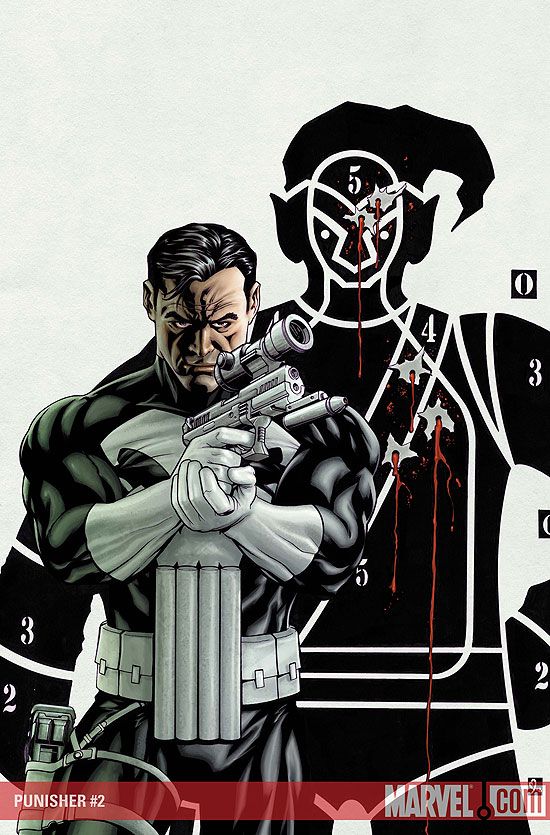That's a nice Mike McKone cover isn't it? An homage to probably the best Punisher cover of all time - Mike Zeck's illustration for the third issue of the original "Punisher" miniseries -- with that silly little Green Goblin hat added for the extra gag. If I were 13 years old, I would want a poster with that image on it. I'd hang it right next to my "Watchmen" movie poster and declare myself the coolest kid on the block.
The contents of "Punisher" #2 may not live up to the implicit greatness of the cover image, but there are more than a few thematic and contextual parallels. Like the cover image, this issue stays true to the Punisher's past while providing a slightly off-kilter spin. The bulk of this issue is filled with stuff we've seen before (in pretty much every incarnation of the character), with the Punisher hooking up with a tech-savvy new associate, a scene in which the Punisher makes his fierce declaration of principles, a raid on an armory, shooting, dead bad guys, worried reactions from the even-badder guys.
So, like the cover, maybe this entire comic is an homage to Punisher stories of the past, with a wink at the audience and a nod to the new "Dark Reign" status quo. Even if that were the case, such an approach doesn't automatically lead to bad comics. It's typical to take old storylines from the past and revamp them for a new era, retell them with current styles.
But that's not what Rick Remender and Jerome Opena are doing here, anyway. What they're doing is answering the question: What would the Punisher do in a world run by Norman Osborn? It's a fundamentally different scenario for the Punisher to be in -- he isn't a rogue vigilante in a world populated with mobsters and drug-runners and slave traders. He's a vicious hero in a world that has been taken over by the supervillain military-industrial complex. It opens narrative possibilities that Matt Fraction didn't have in "Punisher War Journal." It allows the Punisher to play a more important role in the Marvel Universe proper, instead of being relegated to the back-alleys and blackened rooftops.
Such an approach may not work in the long run with a character like Frank Castle, but giving him a chance to take on Norman Osborn (and the forces of eeeeeeevil) is a step up from Stilt-Man, at least. Presumably, the opportunities for conflict will be greater.
Remender is also fortunate to be paired up again with his sometime "Fear Agent" collaborator Jerome Opena, who's scratchy details and weighty physicality are a better match than Ariel Olivetti's digital painting was on Fraction's "War Journal" run.
This isn't a fast-paced series, and that may be to its detriment, but what has been set up seems to work well. After two issues, "Punisher" is primed for a frontal assault on the Marvel Universe, and I'm sure the results will be explosive.

